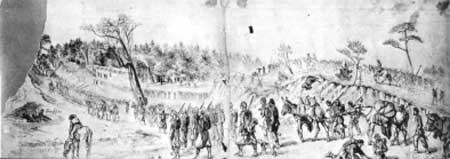|
FREDERICKSBURG and SPOTSYLVANIA COUNTY BATTLEFIELDS MEMORIAL National Military Park |
 |

Early in April 1863 President Lincoln joined
Hooker and the Army of the Potomac for a week's vacation from the
burdens of office. The visit refreshed the care-worn chief executive,
and his friendliness stirred the troops. On April 6 at Falmouth part of
the Army passed in review before Lincoln and his commanders, marching
grandly. Edwin Forbes sketched the parade: Lincoln is on horseback at
the upper left.
Courtesy, Library of Congress.
HOOKER'S PLAN
Hooker did develop a good plan, however. He would take three corps up the Rappahannock to a point northwest of Fredericksburg, then cross both the Rappahannock and the Rapidan to get on Lee's left flank and rear. Two corps would stay in front of Fredericksburg to hold the Confederates in their defensive positions, while the remaining two corps would be held ready to go wherever the best opportunity presented itself. The men would carry 60 rounds of ammunition, and 8-days' rations of hardtack, salt pork, coffee, sugar, and salt. Each ration weighed 3 pounds. For the first time in the east, 2,000 pack mules would be used instead of the usual supply wagons to speed up the movement. The cavalry corps would take off on a raid to disrupt Lee's communications with Richmond.
Hooker reasoned that with three Federal corps on his rear, Lee would have to retreat toward Richmond, and in retreating would, in effect, be executing a flank movement across Hooker's front, a movement generally regarded as suicidal if performed in front of an aggressive commander. Hooker was supposed to be aggressive. His orders to his cavalry commander certainly sounded that way when he reminded him that "celerity, audacity and resolution are everything in battle. Let your watchword be fight, fight, fight."

Hooker's columns push in orderly ranks along the
north bank of the Rappahannock on their way to Kelly's Ford on April 30,
1863. The sketch is by Edwin Forbes.
Courtesy, Library of
Congress.
The campaign got underway April 27 when Meade's V, Howard's XI, and Gen. Henry Slocum's XII Corps started up the Rappahannock, crossing it the next day at Kelly's Ford. "For miles nothing could be heard but the steady tramp of the men," wrote one campaigner, "the rattling and jingling of canteens and accouterments, and the occasional 'close-up-men-close-up' of the officers." On April 29 they crossed the Rapidan at Ely's and Germanna Fords and by April 30 reached Chancellorsville, a strategic crossroads on the edge of an area known as the Wilderness.
While this flanking march of some 40 miles was taking place, Couch's II Corps and Gen. Daniel Sickles' III Corps bluffed a crossing at U.S. Ford on the Rappahannock in an attempt to deceive Lee as to Hooker's intentions. When he completed the flank march, Hooker order the two corps to cross the river and join him at Chancellorsville. This left Reynolds' I Corps and Gen. John Sedgwick's VI Corps opposite Lee at Fredericksburg.
So far everything had worked perfectly. "I have Lee in one hand and Richmond in the other," Hooker boasted.

|
|
Last Modified: Mon, Dec 2 2002 10:00:00 am PDT |


